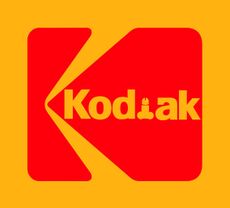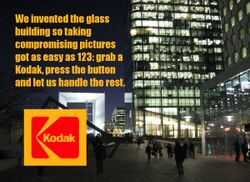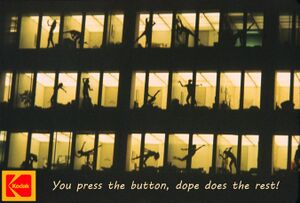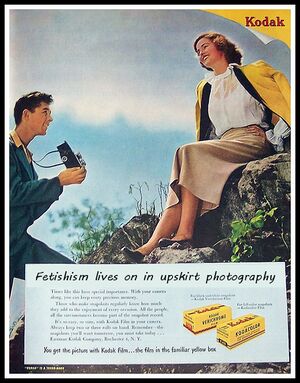Kodak
| Type | bankrupt |
|---|---|
| Predecessor | The Beastman Cave Painting Company (1881 B.C.) |
| Established | 1881 A.D. |
| Founder(s) | 'Peeping' George Beastman |
| Headquarters | Roc Bottom, New York, United States |
| Area served | Worldwide, except Japan |
| Key people | Elmo |
| Industry | Vintage Pornography |
| Products | Imaging and photographic materials, equipment and services, blackmail and indecent exposure |
| Revenue | ▼ United States Dollar 0 (2014) |
| Net income | ▲ none (2015) |
| Employees | 0.5 (2016) |
| Website | www.kodak.com |
Peeping George Company, commonly known as Kodak, is an American business that specializes in obsolete photographic technology. The company was established by George Beastman, the first American voyeur who realized that photography could help popularize his hobby and bring it to the mainstream.
Kodak used to provide photo cameras, film and paper for most of the 20th century, holding a dominant position on the global market. Since the advent of digital photography, Kodak has been filing for bankruptcy twice a day, excepting weekends and public holidays, when it files several times a day.
Name
Mr. Beastman had a penchant for hiding his true intentions since he was caught red-handed by his parents when peeping at his older sisters while they were bathing. Thus he thought of a name that did not mean anything kinky in particular. He initially chose Kodiak for this purpose, but soon dropped the 'i' because of the phallic appearance of this letter. So he only kept the emasculated 'Kodak'. Smart move, Mr. Beastman!
History
From the very first day, Mr. Beastman followed the razor and blades strategy, selling the cameras for peanuts and charging an outrageous amount of money for the consumables. He amassed a huge fortune in very little time and this allowed him to become a philanthropist. He established the Beastman Voyeuristic Think Tank and the Beastman Institute of Voyeuristic Architecture, which invented and promoted the modern transparent glass building, because the main limiting factor in a voyeur's activity are the walls and the doors. Entirely replacing these structures with glass now allows everybody to enjoy this harmless pastime.
Company slogan
Part of Beastman's success was his business sense, which allowed him to see the addictive potential of photography. He strongly believed that taking pictures could spread just like smoking, drinking and substance abuse so he targeted his ads toward people who already had some form of addiction and were prone to also get hooked to his products. Kodak's slogan "You press the button, dope does the rest!" does not make any sense, but was wildly successful. This paradox was the start of the modern era in advertising. Nowadays all slogans, scripts and catchphrases are incoherent.
Competitors
Initially Kodak faced strong competition from Fuji Film and Röntgen Corporation. Fuji planned to build a huge mountain in the middle of every city, that every pervert could climb and peep through the windows at his victims, while Röntgen Corp. proposed X-ray technology to see through the existing walls. Exhibitionists opposed both technologies, invoking the risks associated with avalanches and malignancy, so Kodak's greener technology eventually won.
Heyday
Kodak's income peaked in the 70's and 80's, when the abundance of drugs and the hippie culture helped the pervert inside every man and woman come out and play. The company's ubiquity was such that its tagline "Kodak moment" entered the common lexicon to describe an embarrassing personal event that was unfortunately recorded for posterity.
The company became so popular that spending on publicity could not increase the sales any more. The market was saturated. The only thing that could be done was to make people shoot more photos a day. That's why they passed on the unique opportunity to become the official sponsor of the 1984 Los Angeles Olympics: they had already switched to hiring streakers, who artificially created Kodak moments in front of large audiences.
Suicide
Kodak engineers designed the first digital camera as early as 1975, and back in 1987 they invented the OLED display, which eventually replaced photographic paper. Kodak had the means to remain at the top of its game indefinitely, but George Beastman decided to kill himself and his company. So he gave those patents to competitors and hanged himself to a tree with celluloid film, for one last Kodak moment in the park. Then he tied himself to a bunch of Instamatic cameras and took a dip in Lake Ontario. And finally, he shot himself several times with a Starmatic camera.
This kind of suicidal behavior is a common American practice at an even higher scale. They bravely fight to free oppressed countries, but pull out their troops before stabilizing them... as opposed to the Russian reversal, the treacherous habit of infiltrating free countries and never, ever leaving.
As expected, Kodak shares were worth their weight in toilet paper the instant the first digital cameras went on sale at Walmart. Since then, photos could be directly uploaded to the Internet, rendering chemical processing and optical scanning obsolete. In stock exchange broker parlance, it was Hammer Time for Kodak.
Products and services

Each Kodak product is a fine example of engineering with the pervert needs in mind. No detail was left to chance and no expense was spared to make the sneaky bastards feel that they could rely on their cameras. Kodak cameras were so sought after by the twisted that lines would form around dealerships whenever new shipments arrived. Many deranged people were seen caressing their Kodak cameras and some even married them.
Cameras
The Kodak Brownie Camera was an instant success. It had the appearance of an ordinary lunch box that any pervert could carry without raising suspicion. It had a matte brown finish that allowed for great camouflage in urban areas both during the day and at night. The rough surfaces provided excellent grip for the sweating palms of the perverts and the inner workings were protected by cum-proofed O-rings. It was truly perfect. Subsequent models were lighter and smaller, being easier to conceal. The pinnacle of Kodak engineering were the Kodak Belly Button Camera and the Kodak Oral Camera, so small that they could fit in body cavities. Another revered Kodak product was the 'Cockwork Orange Camera', an automated camera with rounded edges that victims could forcibly swallow or get it shoved up their lower parts to capture the most intimate images ever recorded on film.
Camera centers
Mr. Beastman was a smart beast-man. He figured that he could double his earnings by blackmailing his customers. He offered to process films and print photos in his centers, but he made sure he kept a copy of those Kodak moments for himself. The Kodak local dealers were responsible for sorting indecent photos, identifying the subjects and collecting ransom from both the photographers and their models. Perverts were then sold overpriced Kodak products, in order to mask the true nature of the bargain and to provide them with fresh supplies for future misdemeanors. Everything went really smooth. The blackmailed never complained, because they knew that 'Peeping' George personally reviewed and truly enjoyed their work. Sometimes he directly reached out to them, to provide precious advice on how to improve their technique and compositions.
This business line was so productive, that you could find a Kodak Center even in the most remote areas of the Solar System. Speculation suggests that Moon Landings have been discontinued due to the practices of the local Kodak shop, which abused its dominant position in the Moon market, ripping-off and embarrassing the astronauts on each occasion.
Cultural impact
Kodak is credited for bringing to the masses a fine method of embarrassing women and Scotsmen: upskirt photography. A built-in automated light meter eliminated the guess work and made sure the optimum exposure was automatically set when cameras were operated in the shade of lower garments. You didn't have to be an expert in photography or have the cooperation of your models any more. Any Peeping Tom could get instant results at the push of a shutter button.
Kodak cameras were produced in huge numbers and can still be found in almost every household, although not for their initial purpose. They are now the most popular place to stash weed; large enough to hide a few grams, but completely devoid of street value, so nobody would have any reason to steal them.
Controversy
In 1984, the United Perverts of America Union filed a class-action lawsuit against Kodak, following numerous reports of schlong injuries sustained while changing film rolls. The user manuals did not specify that this operation had to be performed only by hand, so people who used softer body parts for this job were put in harm's way. The case was settled out of court, when Kodak threatened to release the not so legal pictures that the claimants were shooting with those cameras.
Trivia
- To this day, Indians still believe Kodak stole the souls of their ancestors and stored them into photographic plates. George Beastman capitalized on this opportunity and initiated a highly lucrative bogus buy-back program.
- The only thing in the world that could resurrect Kodak from commercial death and make its sales soar again is if President Barack Obama were to introduce background checks for people who buy old school cameras and film.
- President Kennedy loved getting shot with Kodak cameras.
- Kodak offered to sell Apple the patent for its bio cameras: midget slaves glued to the lens, that are trained to draw what they see. And Apple actually bought it.
- During the Cold War, The Soviets copied technology and reverse engineered products from Kodak, selling them under the brand name Kadok, in an effort to hurt the Imperialist economy.
- Of the $ 111 billion that the US spent on the Vietnam War, most of it was on Kodak film reels. They could have paid for guns and nukes and they would have won, but then they couldn't have been able to prove it, because there would have been no money left for photographic evidence. It was a tough choice, but it was the right one. Setting those people free would not have brought any benefit, but that film was later put to good use, documenting Saddam Hussein's WMD. Too bad it's classified.
| Featured version: 7 April 2016 | |
| This article has been featured on the main page. — You can vote for or nominate your favourite articles at Uncyclopedia:VFH. | |





